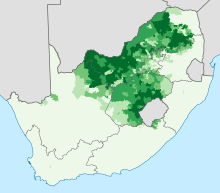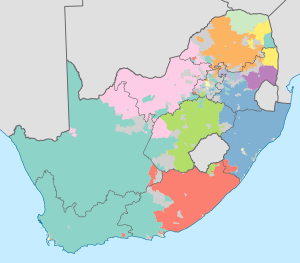Sotho-Tswana peoples
The Sotho-Tswana peoples are a meta-ethnicity of southern Africa and live predominantly in Botswana, South Africa, Lesotho. The group consists of the Southern Sotho(Sotho), Northern Sotho(which consists of the Pedi, the Lobedu and others), and Tswana sometimes known as Western Sotho.
| Total population | |
|---|---|
| unknown; roughly 15–18 million | |
| Regions with significant populations | |
| 13.585 million | |
| 2.130 million (mostly Sotho) | |
| 2.160 million (mostly Tswana) | |
| Languages | |
| Southern Sotho, Northern Sotho, Tswana, Lozi | |
| Religion | |
| African traditional religion, Christianity | |
| Related ethnic groups | |
| Nguni people, Venda people, Tsonga people | |


The Sotho-Tswana people would have diversified into their current arrangement during the course of the 2nd millennium, but they retain a number of linguistic and cultural characteristics that distinguish them from other Bantu-speakers of southern Africa. These are features such as totemism, a pre-emptive right of men to marry their maternal cousins, and an architectural style characterized by a round hut with a conical thatch roof supported by wooden pillars on the outside. Other major distinguishing features included their dress of skin cloaks and a preference for dense and close settlements, as well as a tradition of large-scale building in stone.
The area now settled by the various Sotho-Tswana groups was reached by the Bantu expansion by about AD 500. The standard theory asserts that the Sotho-Tswana are descended from a group that moved southward from the Great Lakes in a separate movement from the other Southern Bantu groups, proceeding along the western part of present-day Zimbabwe.
Ethnonym
The Sotho-Tswana ethnic group derives its name from the people who belong to the various Sotho and Tswana clans that live southern Africa. While Historically, all members of the group referred to themselves as Sothos, the name is now exclusively applied to speakers of Southern Sotho who live mainly in Lesotho, and the Free State province in South Africa. While Northern Sotho, is reserved for the Pedi people (Sepedi: Bapedi) that inhabit northern South Africa, predominantly in Limpopo.
Sotho Ethnonym
According to Jules Ellenberger (1912:34), the Basotho name was derived from the name "Abashuntu" a derivate of the Nguni saying "uku Shunta" meaning "to make a knot". The then Batlokwa, who were the very first people to be called "Abashuntu", used to wear a breech cloth with three ends, one of which passed between the legs and joined the other two knot behind, this mode of dress is called the tshega/tshea. This designation, through bestowed in derision, was adopted with pride by the Batlokwa, and later by other Sotho-Tswana clans similarly clothed and is thought to be the origin of the term "Basotho"
Tswana Ethnonym
The ethnonym Batswana is thought to be antonyms that come from meaning of the Sotho-Tswana word "tswa", which means "to come out of". The name would be derived from the word "Ba ba tswang" eventually shortened to the word Batswana meaning "The Separatists" or alternatively "the people who cannot hold together". One of the chief characteristics of the Sotho-Tswana clans is the tendency to break up and hive off.
Names
The term Tswana can be used to refer to one of the following
- All the Tswana clans residing either in Botswana, Namibia, Zimbabwe or South Africa
- Any member of the Sotho-Tswana clans that trace their origin from Kgosi Mokgatle.
- Citizen of Botswana regardless of linguistic or ethnic origin
- Members of the eight major Sotho-Tswana clans as defined in the Chieftainship Act of Botswana.
- Members of the Sotho-Tswana clans that reside in Botswana, South Africa that speak a standardised dialect of the Sotho-Tswana called Setswana sometimes also referred to as the Western Sotho.
- Any Sotho-Tswana clan that inhabits the Kalahari Desert basin and its eastern and south-western peripheries, unless they are Kgalagari people, who are a different Sotho-Tswana group of tribes.
The term Basotho can be used to refer to the following
- Citizen of Lesotho regardless of linguistic or ethnic origin
- Any member of the Sotho-Tswana clans that trace their origin from Kgosi Mogale
- Members of the Sotho-Tswana clans that came together under the leadership of Moshoeshoe during the Difaqane.
- The Sotho-Tswana clans that stay in the Free State and Lesotho that speak a standardised dialect of the Sotho-Tswana language called Sesotho and sometimes referred to as the Southern Sotho
Classification
In Sotho-Tswana society each member has a totem which is usually an animal, totems are inherited from the father and thus pass like an English surname. The totem animal had traditionally a status of veneration and avoidance: in particular, it was important not to eat one's totem. In modern Sotho-Tswana society this is not as strictly observed. Each morafe/sechaba had its own totem. When naming a clan the name of the founder could be used or the animal they venerate. An example is the Bahurutshe named after the founder Mohurutshe, or alternatively they can also be called Batshweneng after the tshwene (baboon) which they venerate, similarly Batlhako after the founder, or Batloung after the totem. For some clans the name of the founder and their totem are the same like the Bakwena and Bataung where the founders were named Kwena (crocodile) and Tau (lion) respectively.
The question of rank and seniority is one that is very important to the Sotho-Tswana. It determines a lot from family relationships, to village matters to relationships between clans and between the different tribal groups. In a family situation the issue of rank determines when a son will undergo initiation, or receive inheritance. A further distinction is also made between the senior wife and the junior wife if a man is in a polygamous marriage.
As the Sotho-Tswana lived in large villages, seniority and rank also played a part here, where the chief's homestead is situated at the centre of the village, thereafter the other citizen are grouped according to rank where the most junior members are living the furthest from the village centre. For inter and intra relationships between clans it has been a question that has occupied the Sotho-Tswana since the split that occurred between the followers of Mohurutshe and Kwena. While it is generally accepted that the Hurutshe are the senior clan, some of the other clans have disputed this, mainly the Bafokeng, Barolong and Bakgatla. The claims of the Barolong and Bakgatla has mainly been dismissed as for an example some sub clans of Bakgatla like the Bakgatla ba ga Mmakau acknowledge the Bahurutshe as senior while the Bakagatla ba ga Kgafela do not. In the case of the Barolong, the Batlhaping who are an offshoot of the Barolong acknowledge the Bahurutshe to be senior to the Barolong, while the Barolong do not. The Bafokeng maintain that their split from core Sotho-Tswana body predated the split between Mohurutshe and Kwena, and therefore they are equal in status to the Bahurutshe if not senior.
These dispute over seniority and rank were driven by the quest for benefits and independence, a senior kgosi could demand a payment of tribute from a junior chief, they could also summon a junior chief or member of his clan to kgotla for a hearing. If a dispute arose between two junior chiefs the closet most senior chief to them would be invited to resolve it. Another important factor was that a senior chief or members of his clan could not be summoned to the Kgotla by a junior kgosi or clam member. An additional factor is this question of rank and seniority was that it was determined by birth and could not be changed, this means a chief born of minor status could not change his standing relative to the other chiefs. This was mainly to discourage the split up of clans into further sub-clans and to discourage the buildup of clans through conquest and warfare.
An important distinction needs to be made when discussing Sotho-Tswana clans is to distinguish between the different clans and the various sub-clans below them. This means distinguishing between clans sharing the same totem like the crocodile but are distinct such as the Bapo, Bakwena, Bangwaketse and Bafokeng of Phokeng. In distinguishing between sub clans an example are the Bakgatla who separated into the Bakgatla ba Kgafela and Bakgatla ba ga Mmakau over who should lead the clan. One faction defied the usual tradition of male leaders and acknowledged the female, Mmakau, as their kgosi. Those who supported Kgafela then broke away.[1] Further offshoot from the Bakgatla are the Bakgatla ba Mmanaana, Bakgatla ba Mmakau and Bakgatla ba Motsha who all have the kgabo as their totem. The Bakgatla ba Mmakau would later give rise to Bapedi, Bakholokoe, Batlokwa, Baphuti and Basia clans [2][3] If a dispute was to arise between any of the offshoot clans like the Basia and Baphiti then the Mmakau chief would be tasked with resolving it as their senior
References
- André Croucamp and Bea Roberts (2011) A short history of the Bakgatla ba Kafela, Totem Media (Pty)Ltd, p 1
- "Archived copy". Archived from the original on 21 October 2014. Retrieved 21 October 2014.CS1 maint: archived copy as title (link)
- "Archived copy". Archived from the original on 21 October 2014. Retrieved 21 October 2014.CS1 maint: archived copy as title (link)
- Mesthrie, Rajend (1995). Language and Social History: Studies in South African Sociolinguistics. p. 49. ISBN 0-86486-280-6.
- Setiloane, Gabriel M. (1976). The Image of God Among the Sotho-Tswana. ISBN 90-6191-007-2.
- http://www.namibian.org/travel/namibia/population/tswana.htm
- Totem Media. (2010). Mining the Future – The Bafokeng Story. ISBN 978-1-77009-824-4.
- Kobus du Pisani. (2010). The Last Frontier War:Braklaagte and the Battle for Land Before, During and After Apartheid. ISBN 978-9-03610-090-8.
- http://mphebathomuseum.org.za/?q=node/42